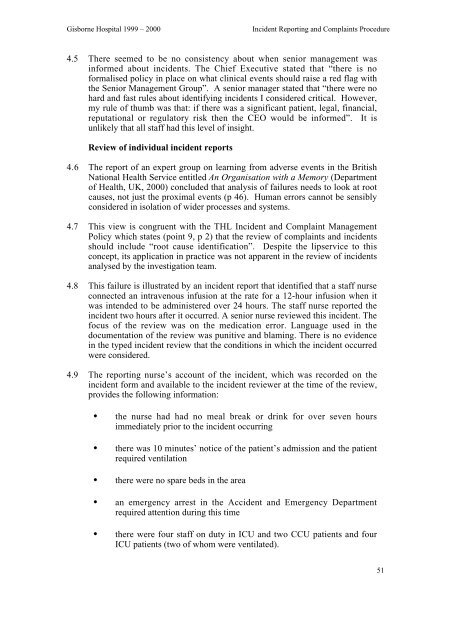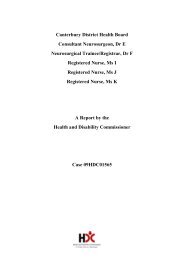Gisborne Hospital Report - Health and Disability Commissioner
Gisborne Hospital Report - Health and Disability Commissioner
Gisborne Hospital Report - Health and Disability Commissioner
Create successful ePaper yourself
Turn your PDF publications into a flip-book with our unique Google optimized e-Paper software.
<strong>Gisborne</strong> <strong>Hospital</strong> 1999 – 2000<br />
Incident <strong>Report</strong>ing <strong>and</strong> Complaints Procedure<br />
4.5 There seemed to be no consistency about when senior management was<br />
informed about incidents. The Chief Executive stated that “there is no<br />
formalised policy in place on what clinical events should raise a red flag with<br />
the Senior Management Group”. A senior manager stated that “there were no<br />
hard <strong>and</strong> fast rules about identifying incidents I considered critical. However,<br />
my rule of thumb was that: if there was a significant patient, legal, financial,<br />
reputational or regulatory risk then the CEO would be informed”. It is<br />
unlikely that all staff had this level of insight.<br />
Review of individual incident reports<br />
4.6 The report of an expert group on learning from adverse events in the British<br />
National <strong>Health</strong> Service entitled An Organisation with a Memory (Department<br />
of <strong>Health</strong>, UK, 2000) concluded that analysis of failures needs to look at root<br />
causes, not just the proximal events (p 46). Human errors cannot be sensibly<br />
considered in isolation of wider processes <strong>and</strong> systems.<br />
4.7 This view is congruent with the THL Incident <strong>and</strong> Complaint Management<br />
Policy which states (point 9, p 2) that the review of complaints <strong>and</strong> incidents<br />
should include “root cause identification”. Despite the lipservice to this<br />
concept, its application in practice was not apparent in the review of incidents<br />
analysed by the investigation team.<br />
4.8 This failure is illustrated by an incident report that identified that a staff nurse<br />
connected an intravenous infusion at the rate for a 12-hour infusion when it<br />
was intended to be administered over 24 hours. The staff nurse reported the<br />
incident two hours after it occurred. A senior nurse reviewed this incident. The<br />
focus of the review was on the medication error. Language used in the<br />
documentation of the review was punitive <strong>and</strong> blaming. There is no evidence<br />
in the typed incident review that the conditions in which the incident occurred<br />
were considered.<br />
4.9 The reporting nurse’s account of the incident, which was recorded on the<br />
incident form <strong>and</strong> available to the incident reviewer at the time of the review,<br />
provides the following information:<br />
• the nurse had had no meal break or drink for over seven hours<br />
immediately prior to the incident occurring<br />
• there was 10 minutes’ notice of the patient’s admission <strong>and</strong> the patient<br />
required ventilation<br />
• there were no spare beds in the area<br />
• an emergency arrest in the Accident <strong>and</strong> Emergency Department<br />
required attention during this time<br />
• there were four staff on duty in ICU <strong>and</strong> two CCU patients <strong>and</strong> four<br />
ICU patients (two of whom were ventilated).<br />
51
















